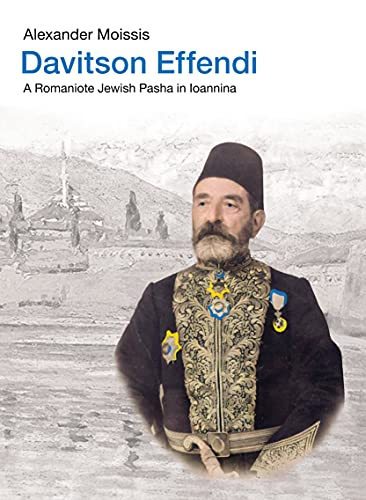Alexander Moissis
Davitson Effendi, A Romaniote Jewish Pasha in Ioannina
Athens: Kapon Editions; English, Greek, 2021, ISBN: 9798516310287
Reviewed by Annette B. Fromm1
This book about the remarkable Jewish statesman, Davitson Effendi Levis (1832-1913), a native of Ioannina in northwestern Greece, is more than a biography. It is well-researched, highly personal biographical study, written by a descendant of the book’s namesake and protagonist. In fact, as Moissis emphatically points out, two protagonists inhabit this book, Davitson Effendi and the city of Ioannina, and they are both indelibly Greek. Davitson Effendi was elemental to many of the changes taking place in the Ottoman Empire in the late nineteenth century. As Ioannina, the home of his ancestors, was incorporated into the modern Greek nation early in the twentieth century, he was also central to the numerous changes there. Both players acted together.
Historical events at the close of four hundred years of Ottoman rule are interwoven throughout the text about the life of this astounding and extraordinary man. The author has taken the challenge and not-so-easy job of showing how Ioannina fit into the Ottoman Empire from the mid-nineteenth to early twentieth century, a period of time in which rapid change was transforming the face of the Eastern Mediterranean and the rest of Europe. He has assembled a very readable narrative that amply documents the multi-faceted times in which Davitson Effendi lived from various archives in the region. He quotes from them copiously.
Throughout the book, the decline of the Ottoman Empire resulting from the economic and industrial weaknesses to its military defeats from the eighteenth century onward is traced. The narrative also follows the life and professional career of Davitson Effendi Levis as the author discusses the significant role he played in the reform movements of state organization, trade, and the justice system. He also details his role in reorganizing the judicial structure and restoration of Turkey’s finances. His efforts in court, as reported by the author, were to “… combine ideas from the West with Ottoman legal tradition and … Islamic Law or sharia” (p. 166). An explanation of and analysis of the connection between Davitson’s life and career and the efforts toward restructuring and modernization in the Ottoman Empire in the late nineteenth century are provided in great detail. He also participated in the modernization of the city of Ioannina.
Who was Davitson Effendi, this Jewish businessman from Ioannina? Drawing from sources for Turkey, Greece and elsewhere, Moissis carefully traces his political accomplishments, especially his efforts to bring about harmony between the fading Ottoman government and European powers. Because of the lack of documents, the text is full of conjecture. Noting his service in the public sector, the author writes that “… Davitson was probably also active in the Levis family business” (p. 72). He also details his role in Ioannina’s economy and in the Jewish community of the city.
Effendi, the honorific conferred on Davitson Levis, indicated that he was a “trustworthy and capable government official …who … played a key role in the return of Ottoman power from the provinces back to the throne and to the Porte” (p. 51). Moissis points out two other contemporary Turkish politicians named Davitson Effendi, one from Constantinople and the other from eastern Thrace.
The author visually sets the scene throughout the text with a good number of historic illustrations of Ioannina and elsewhere in the Ottoman Empire, the Greek Republic and Europe. Also illustrating the text is a number of photographs taken by Nissim D. Levis, one of Davitson Effendi’s sons.
A map, or several maps, especially in later chapters for readers unfamiliar with the region, would have added to their ability to visualize locations written about. In addition, Moissis carefully cites his abundant sources in footnotes; a bibliography and perhaps even an index would have been a welcome addition. A few foibles, probably the result of translating, appear in the text. These include a brief mention of “… Sadowa (in present-day Czechia) …” (p. 89) rather than Czech Republic; a reference to “Turkabanians” (p. 177); and inconsistencies, such as “Israeli Community of Ioannina” (p. 182, p. 213) and “non-Israelite neighbors” (p. 184).
Moissis has unearthed a history that had not been preserved in “the family’s collective memory” (p. 213) by assembling the complexities of his own family history, facts, and interrelationships.
This book is a companion to an earlier publication by the same author that focuses on the stories told by a rich collection of family photos, 1898-1944 the Nissim Levis Panorama: Stereoscopic Photos and Travels of a Doctor from Ioannina.2 Davitson Effendi, A Romaniote Jewish Pasha in Ioannina is a contribution to the growing literature about the history of Jews in Greece. The Greek-speaking Jewish community of Ioannina is overdue for serious research of which this book can be counted a part.
1 Annette B. Fromm is a museum specialist, folklorist, and lecturer in Romaniote and Sephardic studies and associate editor of Sephardic Horizons.
2 Alexander Moissis. 2016. 1898-1944 The Nissim Levis Panorama: Stereoscopic Photos and Travels of a Doctor from Ioannina. Athens: Kapon Editions.
Copyright by Sephardic Horizons, all rights reserved. ISSN Number 2158-1800

